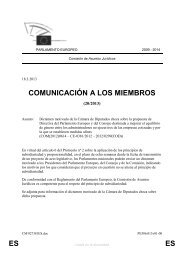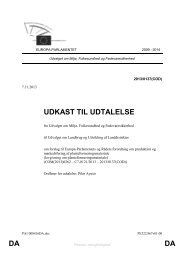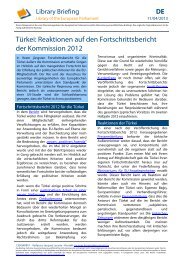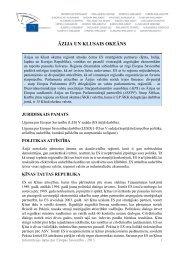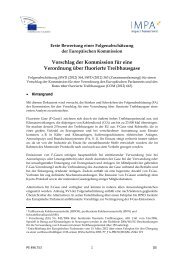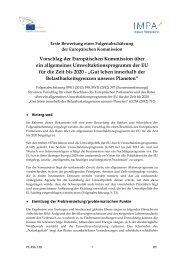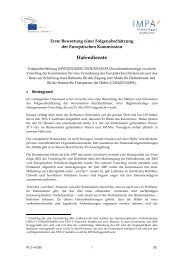Link to the study - European Parliament - Europa
Link to the study - European Parliament - Europa
Link to the study - European Parliament - Europa
Create successful ePaper yourself
Turn your PDF publications into a flip-book with our unique Google optimized e-Paper software.
Nuclear Decommissioning: Management of Costs and Risks<br />
____________________________________________________________________________________________<br />
decommissioning process. The good practice identified so far should be continued and upgraded <strong>to</strong><br />
match <strong>to</strong> <strong>the</strong> upcoming more sensitive worksteps.<br />
4.7. COST ESTIMATES<br />
Cost planning is a fundamental requirement for any project. Without a transparent and as detailed as<br />
possible (at a certain project stage) cost planning it is not possible <strong>to</strong> obtain financing of a<br />
decommissioning project. And without secured financing it is not possible <strong>to</strong> perform a project. At<br />
<strong>the</strong> same time <strong>the</strong> cost planning is <strong>the</strong> basis for <strong>the</strong> cost controlling of <strong>the</strong> project. Cost planning is<br />
only reliable if it is based on:<br />
A detailed planning, identifying all steps <strong>to</strong> be made;<br />
Inven<strong>to</strong>ry data for masses and contamination;<br />
A thorough risk evaluation.<br />
4.7.1. Cost estimates of <strong>the</strong> decommissioning projects<br />
Bulgaria<br />
Bulgaria performs cost estimates on <strong>the</strong> basis of (see ANNEX 3)<br />
A detailed work plan (work breakdown structure);<br />
Underlying sub-tasks on <strong>the</strong> second level;<br />
Estimated labor costs; investment costs; operating costs and incidental costs for those activities.<br />
Bulgaria applies <strong>the</strong> cost estimation standards as recommended in (NEA 2013), which are based on an<br />
explicit project management approach.<br />
38 % of <strong>the</strong> <strong>to</strong>tal costs are labor costs (ANNEX 3). The most influence on changes <strong>to</strong> <strong>the</strong> cost estimates<br />
are seen with adjustments of <strong>the</strong> work schedule.<br />
The differences between previous cost estimates and <strong>the</strong> actual costs are seen as follows:<br />
'The main reasons for <strong>the</strong> divergence in <strong>the</strong> forecast cost appraisals and <strong>the</strong> real ones are due <strong>to</strong> <strong>the</strong><br />
changes made in <strong>the</strong> initial schedule and in <strong>the</strong> terms for implementation of <strong>the</strong> main activities,<br />
ensuring <strong>the</strong> implementation of <strong>the</strong> Decommissioning plan for Units 1-4.' (ANNEX 3, page 151)<br />
This has <strong>to</strong> be seen on <strong>the</strong> background of <strong>the</strong> delays in four projects for waste treatment facilities<br />
(ANNEX 3, page 150). The risk that fur<strong>the</strong>r delays occur, delaying work on critical pa<strong>the</strong>s, can increase<br />
costs fur<strong>the</strong>r. This points <strong>to</strong> <strong>the</strong> already discussed weaknesses of <strong>the</strong> project management<br />
organisation (see chapters 4.5.2 and 4.5.3).<br />
119




